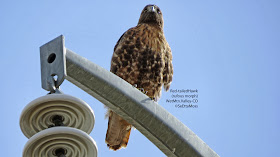Thursday, 31 October 2013
American Pipits at Quivira National Wildlife Refuge in KS
I got in to the Quivira National Refuge in KS late yesterday afternoon. I saw 3-4 of these American Pipits there today.
I caught this pipit in the bottom pic as it appeared to yawn. SeEtta
Tuesday, 29 October 2013
First Harlan's Red-tailed Hawk of the season
I spotted this light morph Harlan's Hawk in eastern Pueblo County, Colorado this afternoon and was able to get a few good flight photos using my Canon 60d dslr camera with 400mm, 5.6 lens.
Distinctive are the white 'spectacles' and pale gray with blackish subterminal band Harlan's type tail. This one has moderately marked underparts with wide black band on rear edge of remiges along with black patagial marks.
Though I have heard of Harlan's hawks being seen in northern parts of Colorado this month this is the first I have seen this fall/winter season. SeEtta
Friday, 25 October 2013
Rufous morph Red-tailed Hawk in Wet Mountain Valley
In addition to the Prairie Falcon I saw a about 6 Red-tailed Hawks around the Wet Mountain Valley this afternoon including this pretty rufous morph. SeEtta
Prairie Falcon in Wet Mountain Valley (Colo)
I found this pretty Prairie Falcon not far from Lake DeWeese. Unfortunately though I stayed in my car (and even turned off the ignition and let it coast to a stop to reduce disturbance) I disturbed it--you can see it is looking right at me. So it flew off before I could get another good photo. SeEtta
Took a time out for injuries
First I had a bad fall and injured my leg--no breaks, no ligament damage but did bruise the bone and lots of soft tissue bruising. That limited my walking a lot as well as time on computer as I needed to keep it elevated. So I started doing car birding until I had a flat tire. Bummer the damage was too much for repairs and due to having an all wheel drive car I had to get a replacement tire that was same brand, same model and about the same tread depth (within a couple of 32nds of an inch). Found exact tire online and it finally came yesterday so today I went to the mountains and photographed birds in above posts. SeEtta
Thursday, 17 October 2013
Williamson's Sapsuckers-first birds of the fall in Canon City
Williamson's Sapsuckers breed in the mountains in Colorado and most apparently migrate south with all but a few birds reported in the state from Oct 1 to around April 1 when they start returning.
Some of those remaining in Colorado come into Canon City in the fall and remain over the winter along with a few Red-naped and Yellow-bellied Sapsuckers.
I found this male and female Williamson's Sapsuckers, the first of the season, in Lakeside Cemetery. Though they briefly fed in the same tree and near each other, it did not last long as the female left the tree to the more dominant male. I have observed this previously with males being more dominant and chasing females away from their feeding location.
Though I have looked every day I had not refound any Williamson's until today when I spotted a male, likely the the one in these photos. SeEtta
Tuesday, 15 October 2013
Greater Spreadwinged Damselfly
I found a good sized population of these damselflies near an irrigation pond in Canon City, CO. Linda Rockwell identified the species as Greater Spreadwinged Damselfly (Archilestes grandis).
When I read about this species on SouthwestDragonflies.net the field marks matched though the "continuous pale yellow side stripe on thorax" as described looks whiter on this damselfly and it may be immature as they note. I thought it was a male because it's top appendage matched their description and drawing.
I submitted photos to BugGuide.net and it was confirmed as as Greater Spreadwing and photos placed in that species online database. It was confirmed as a male on Arthropods Colorado facebook page. SeEtta
Thursday, 3 October 2013
WOOD THRUSH, up close
I took this with my dslr (the others were with my compact camera) with my 400mm lens and then I cropped the photo tightly (which my Canon 60d dslr allows). The spots on it's underparts are heart shaped and extend well down it's flanks. It's black sub malar streak is partially shown and as is it's narrowly streaked side of it's head. The feet show as pinkish. SeEtta
WOOD THRUSH, a rarity in Colorado
I found this Wood Thrush this morning skulking high up instead of low down as they are known to do. It was in a medium sized deciduous tree in the Lakeside Cemetery in Canon City, Colorado-far from it's usual haunts several hundred miles from Colorado. It was not cooperative in letting me see it's field marks as it stayed above me and I was never able to see it's upperparts except for quick views of it's rusty-brown head when it would look down at me when it heard my camera click. In fact when I first spotted it, and it spotted me looking at it, it moved away from my view and worked it's way around the tree so I lost it for about 5 minutes.
After searching nearby trees finally spotted it perched, still, on a branch 20 feet up inside the tree. I was able to see it's white eyering, white (not buffy) underparts with distinct blackish spots from neck to belly and short tail plus rusty-brown head distinguishing it from other thrush species. SeEtta





















